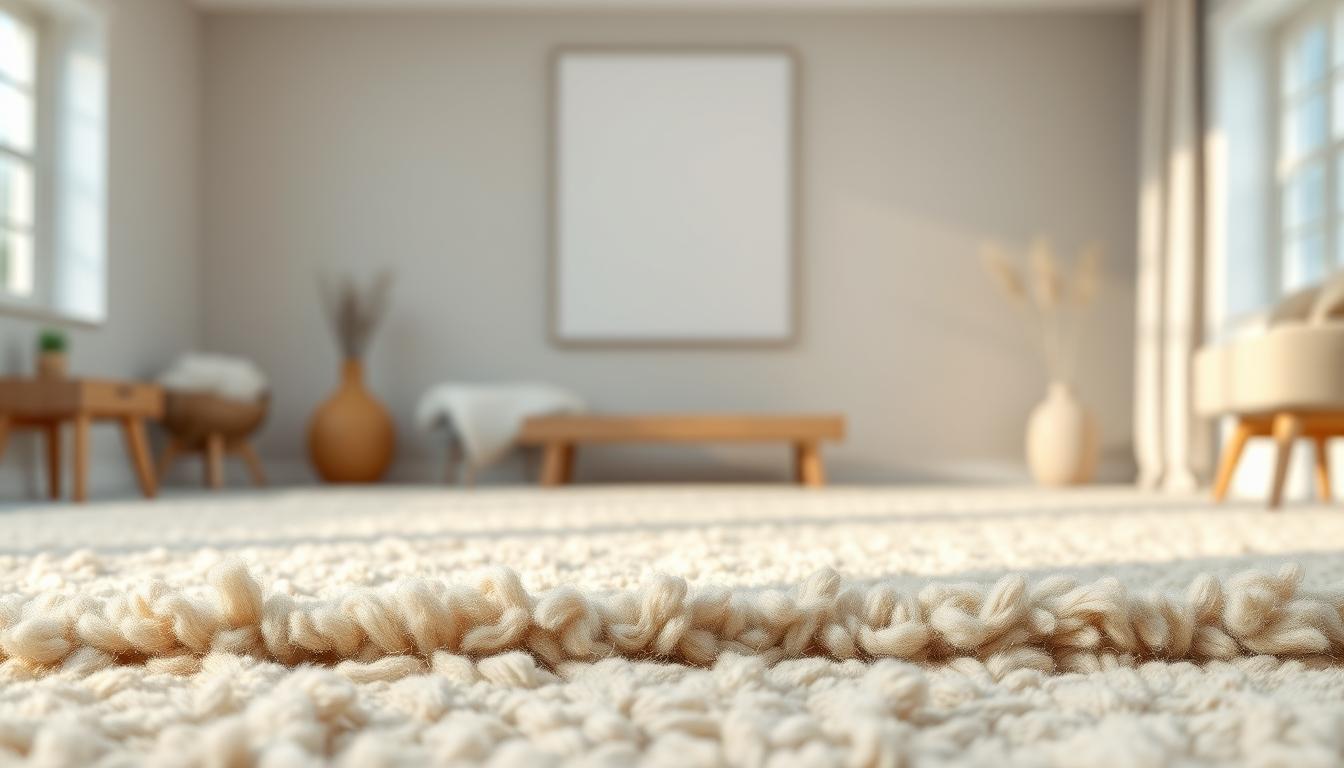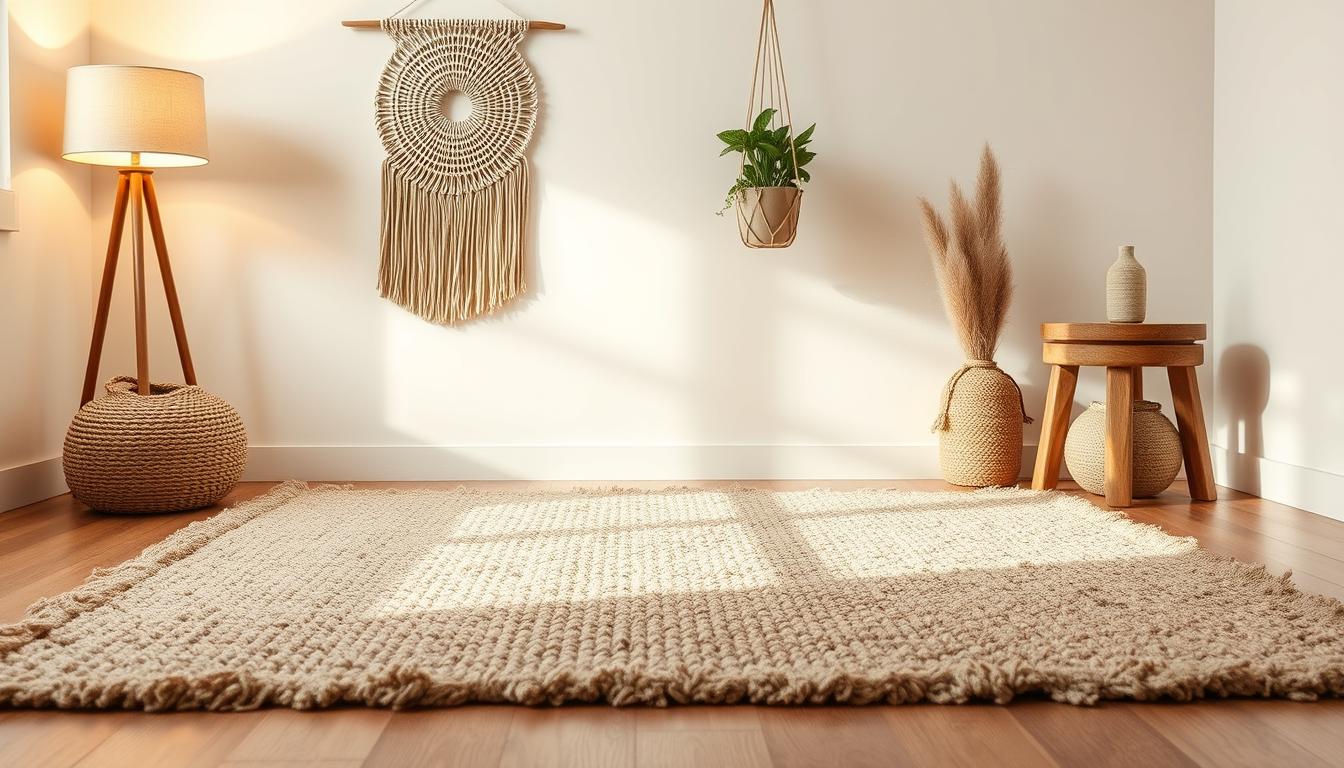
7 Reasons Why Wool Rugs Are Worth It

Imagine stepping onto flooring that grows more beautiful with age while actively contributing to cleaner air. Natural fiber floor coverings offer this rare combination of timeless elegance and functional benefits. Unlike synthetic alternatives, these pieces maintain their shape through decades of use while repelling allergens and dust mites.
Premium floor textiles made from organic materials provide natural insulation, reducing energy costs year-round. Their dense fibers trap warmth during winter while staying cool underfoot in summer. This temperature regulation stems from the material’s unique cellular structure, which synthetic fibers struggle to replicate.
For households with allergy concerns, these floor coverings act as silent guardians. The fibers naturally resist bacteria and mold growth, creating a healthier environment. Discover how their luxurious softness pairs with practical advantages that transcend ordinary home décor.
Artisans craft each piece using techniques perfected over generations, ensuring every knot and weave pattern enhances durability. This meticulous craftsmanship transforms functional items into heirloom-quality assets that appreciate in visual appeal as they age.
Key Takeaways
- Natural fibers resist crushing and maintain structure better than synthetic materials
- Hypoallergenic properties help improve indoor air quality
- Provides thermal insulation that adapts to seasonal temperature changes
- Skilled craftsmanship ensures decades of reliable performance
- Eco-friendly composition supports sustainable living practices
Benefits of Wool Rugs for Enhancing Your Home Decor
Elevate your home’s aesthetic with textiles that offer both visual appeal and health benefits. These natural fiber floor coverings adapt effortlessly to evolving interior design trends while creating healthier living spaces. Their ability to blend functionality with artistic expression makes them transformative elements in any room.
Luxurious Texture and Versatility
The organic fibers create depth through subtle variations in texture, catching light differently than flat synthetic surfaces. Whether your style leans toward bold geometric patterns or muted earth tones, these pieces bridge gaps between contrasting design elements. Their tactile richness invites touch while anchoring furniture arrangements with understated elegance.
From hand-tufted masterpieces to flat-weave simplicity, construction methods influence both beauty and practicality. A vibrant tribal pattern energizes modern minimalist spaces, while neutral hues soften eclectic rooms. This adaptability ensures your flooring investment remains relevant through redecorating cycles.
Improving Indoor Air Quality and Ambience
Natural fibers act as passive air filters, trapping dust particles before they circulate. Unlike plastic-based alternatives, they resist static electricity that attracts allergens. This results in fewer airborne irritants – a relief for households with sensitivities.
The dense structure also dampens sound vibrations, turning echo-prone areas into cozy retreats. Temperature-regulating properties maintain comfortable underfoot conditions year-round. Combined with their visual warmth, these features cultivate spaces that feel both polished and inviting.
The Superior Quality and Durability of Wool Rugs
Long-term value in home textiles comes from materials that improve with age while resisting wear. Studies reveal natural fiber floor coverings last 2.5 times longer than synthetic options, with Bowyer et al. (2019) documenting a 25-year lifespan. This endurance stems from unique biological properties and time-tested craftsmanship.

Longevity and Resilience in High-Traffic Areas
Natural fibers rebound from compression like coiled springs, maintaining loft where plastic-based materials flatten permanently. In entryways or living spaces with constant activity, this elasticity prevents matting and preserves surface texture.
Artisan techniques enhance inherent durability. Double-stitched edges and compact weaving patterns withstand chair movements and footfalls. Unlike mass-produced alternatives, these pieces develop character rather than showing wear.
For homes needing optimal protection in high-traffic zones, the natural crimp of wool fibers acts as built-in shock absorption. This structural advantage keeps surfaces looking newer for decades, reducing replacement costs.
Are Wool rugs good? A Comprehensive Pros and Cons Analysis
When choosing home textiles, balancing practicality with luxury becomes essential. Natural fiber floor coverings present unique advantages that synthetic versions can't match, though they require specific care considerations.
Notable Advantages: Comfort, Insulation, and Stain Resistance
Experience year-round climate control through natural insulation. These textiles retain warmth during cold months while staying cool underfoot in summer heat. Their dense fibers also absorb humidity, helping stabilize room moisture levels.
Spill protection comes built-in thanks to lanolin coatings. This biological feature creates water-repellent barriers, giving you crucial minutes to clean accidents before permanent stains set. "The stain-fighting power outperformed our old nylon rug within the first week," notes a Connecticut homeowner.
| Feature | Benefit | Consideration |
|---|---|---|
| Comfort | Temperature-regulating fibers | Higher initial investment |
| Insulation | Reduces energy costs | Professional cleaning recommended |
| Stain Resistance | Natural spill protection | Initial fiber shedding |
Considerations: Cost, Maintenance, and Shedding
Premium materials demand thoughtful care. Use pH-neutral cleaners to preserve fiber integrity – harsh chemicals cause irreversible damage. While initial shedding occurs, high-quality pieces minimize this through tight weaving techniques.
Though upfront costs run higher than synthetics, longevity justifies the expense. A well-maintained natural fiber textile lasts decades, outliving 3-4 cheaper replacements. For allergy sufferers, the hypoallergenic properties add health value beyond dollar calculations.
Eco-Friendly and Sustainable Benefits of Natural Wool
Choosing home furnishings that align with eco-conscious values starts with understanding material origins. Natural fiber floor coverings stand apart through renewable sourcing and closed-loop lifecycles. Their production supports agricultural practices that regenerate rather than deplete ecosystems.

Sheep regrow their fleece annually, creating a continuous supply chain without resource exhaustion. This contrasts sharply with petroleum-based synthetics derived from finite reserves. When you select ethically made wool textiles, you endorse farming methods that prioritize land stewardship.
Biodegradation occurs naturally within years rather than centuries. Discarded synthetic alternatives release microplastics as they break down, while wool decomposes without toxic residues. This circular lifecycle reduces landfill burdens and ocean pollution.
| Feature | Wool Rugs | Synthetic Rugs |
|---|---|---|
| Renewable Source | Yes (annual regrowth) | No (fossil fuels) |
| Biodegradability | 3-5 years | 20-200 years |
| Production Energy | Low (natural processing) | High (chemical refining) |
| Chemical Use | Minimal | VOCs common |
Manufacturing processes for natural textiles consume 30% less energy than synthetic equivalents. Lanolin in raw fibers eliminates need for artificial stain repellents. These inherent properties create healthier homes while protecting global ecosystems.
Comparing Wool Rugs to Synthetic Alternatives
Flooring decisions shape your home’s functionality and aesthetic for years. Natural fiber textiles and synthetic options present distinct trade-offs in comfort, durability, and environmental impact. Understanding these differences helps you make informed choices aligned with your lifestyle needs.
Material Quality and Craftsmanship Differences
Natural fiber textiles derive resilience from organic structures. Artisans employ hand-knotting and weaving methods that synthetic manufacturing can’t replicate. This craftsmanship creates dense, breathable surfaces that improve with age.
Synthetic alternatives often use machine-tufted construction. While cost-effective, this process creates flat textures lacking depth. Plastic-based materials feel artificial underfoot compared to natural fibers’ springy cushioning.
Performance in High-Traffic and Moisture-Prone Spaces
Natural fibers excel in busy areas due to inherent elasticity. Their coiled structure rebounds from furniture indentations and foot traffic. Synthetic surfaces flatten permanently, developing worn paths over time.
Moisture management differs significantly. Natural fibers absorb and release humidity without trapping odors. Synthetic options may resist spills initially but often harbor mildew in damp environments.
| Feature | Natural Fiber | Synthetic |
|---|---|---|
| Resilience | Self-repairing fibers | Permanent compression |
| Moisture Management | Natural wicking | Odor retention risk |
| Maintenance | Professional cleaning | Machine washable |
| Lifespan | 25+ years | 5-8 years |
While synthetic materials offer stain resistance, they can’t match the natural soil repellency of lanolin-rich fibers. For lasting value, many homeowners prefer natural textiles despite higher initial costs. Explore long-term performance factors when weighing your options.
Maintenance Tips and Care Guidelines for Wool Rugs
Maintaining floor coverings requires techniques tailored to their unique material properties. Simple routines preserve texture and color while extending their lifespan significantly.
Effective Cleaning and Regular Vacuuming Techniques
Weekly vacuuming forms the foundation of textile care. Use suction-only settings or brushless attachments to protect delicate fibers. This prevents fraying while removing dirt trapped in dense weaves.
Address spills immediately using blotting motions – never rub. Mild detergent solutions work best for spot treatment. Harsh chemicals strip natural lanolin coatings that repel stains.
High-quality pieces shed less over time, especially when vacuumed properly. For deeper insights on managing shedding, explore our detailed performance analysis comparing natural and synthetic options.
Rotate your textile every 6-12 months to ensure even wear. Professional cleaning every 18 months removes embedded particles without damaging fibers. These steps keep surfaces looking fresh through years of use.
FAQ
How do wool rugs improve indoor air quality?
Natural wool fibers trap dust, allergens, and pollutants, preventing them from circulating in your home. This makes them ideal for households with allergy sufferers or those prioritizing cleaner air.
Are wool rugs suitable for homes with pets or kids?
Yes. Wool’s inherent stain resistance and durability handle spills and foot traffic well. However, prompt cleaning is recommended for liquid accidents to maintain their longevity and appearance.
How do wool options compare to synthetic materials like polypropylene?
Wool offers superior softness, insulation, and eco-friendliness compared to synthetic alternatives. While polypropylene resists moisture better, it lacks the natural warmth and biodegradability of wool.
Do wool rugs shed over time?
Some shedding is normal initially but diminishes with regular vacuuming. High-quality wool options from brands like Safavieh or Jaipur Rugs are tightly woven to minimize this issue.
Can wool rugs be used in moisture-prone spaces like bathrooms?
Avoid placing them in damp areas. Wool absorbs humidity, which can lead to mold. Instead, opt for synthetic materials like nylon in bathrooms or basements.
What makes wool a sustainable choice for flooring?
Wool is renewable, biodegradable, and requires fewer chemicals during production compared to synthetic fibers. Brands like Lorena Canals prioritize eco-friendly dyes and ethical sourcing.
How often should I vacuum a wool rug?
Vacuum 1–2 times weekly to remove dirt and prevent matting. Use a suction-only setting—avoid rotating brushes, which can damage fibers over time.
Are wool rugs worth the higher upfront cost?
Yes. Their durability ensures they last decades with proper care, while synthetic options often need replacement every 5–7 years. The long-term value and timeless design justify the investment.









